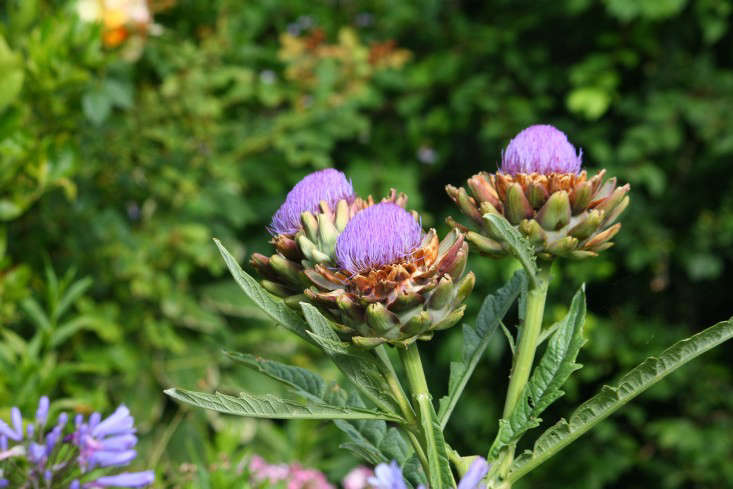Thistle, Cynara, Cirsium, Carduus, Echinops, Onopordum: “Spiky Cousins”
It is easy to see why thistles, their foliage bristling with tiny spikes, sometimes get a bad rap. Anyone who has stumbled into a patch of thistles on a hike remembers the helpless feeling of being pricked by a hundred little needles. Perhaps that is why the poet Ted Hughes describes thistles “like pale hair and the gutturals of dialects. Every one manages a plume of blood.”
Every one? Did the poet laureate once have a bad experience with a clump of thistles? Many members of the Asteraceae family go by the name of thistle—from invasive Onopordum acanthium to the friendly globe artichoke; we think it’s a bit dramatic to lump them all together.
What thistles do have in common is that they make a beautiful addition to cottage and seaside gardens, with their unique texture and bright, spiny flowers.

The secret is that thistles, though they can grow in abandoned fields, with a bit of help from you can look less ragged and more refined. In fact, in the Celtic tradition, thistles were thought to symbolize a noble character, someone too dangerous and proud to be messed with. Their silvery green foliage, with the stems pointing in all directions, makes thistle a wonderful candidate for a dried bouquet.

If it is flowers you want, either in a living bouquet or dried, try planting the globe thistle. Fluorescent purple orbs—covered in tiny spines, of course—balance atop stems that are almost white. The effect is otherworldly.
Cheat Sheet
- These prickly plants will not be eaten by deer or squirrels.
- Grows well in sandy soil and as a companion for other beach plants ( try the beach pea, northern bayberry, and rosa rugosa).
- Silvery green foliage; flowers can be purple, pink, white, or red.
Keep It Alive
- Thistles thrive in full sun; plant them in autumn.
- Water weekly or more in very hot weather.
- A mature clump of thistles can be up to 4 feet wide so give it a significant space.

Some thistle varieties produce magenta flowers that look like little fireworks. Others appear to have long silky white hair or to be sprouting cherry-colored snow cones. These fast-growing plants can take up more than four square feet, so when you plant in autumn, be sure to allow them a wide berth.

Thistles actually require a lot of water, once or even twice a week during dryer spells. For an overgrown, cottage look let your thistles grow freely, but if you want them tamer, no need to spare the shears.
For more about the prickly personalities of thistles, see:
N.B.: Hoping to find deer resistant plants? Our Garden Design 101 guides can help:
- Lavender 101, Milkweed 101, and Cala Lily 101 are just a few of the options to explore.
- If you’re looking to start anew, our Hardscape 101 guides can take you through your project, beginning to end.








Have a Question or Comment About This Post?
Join the conversation